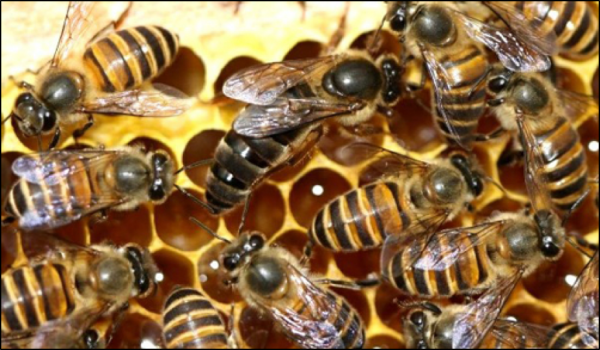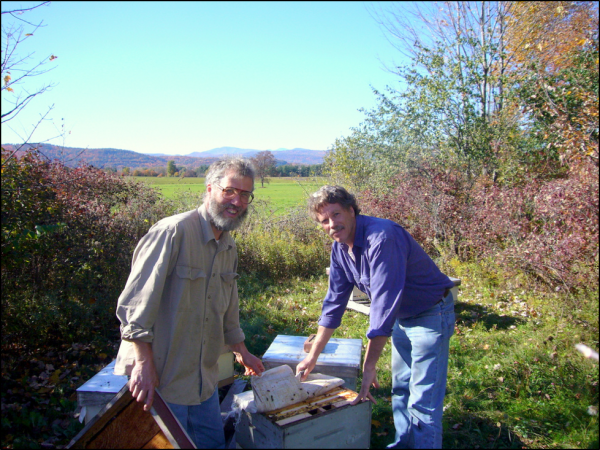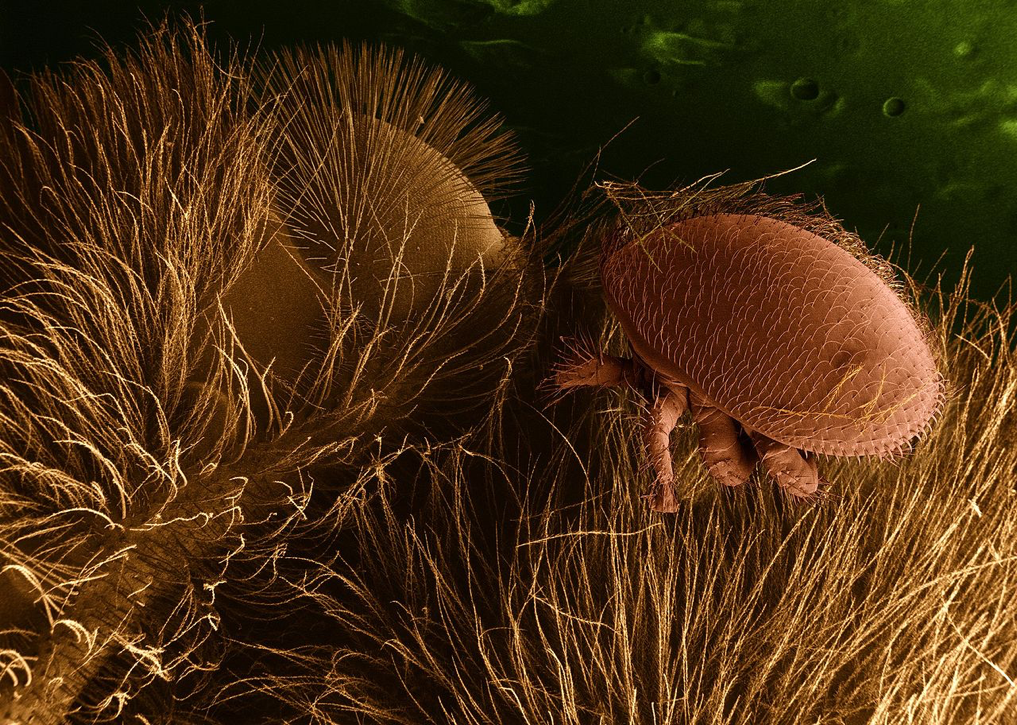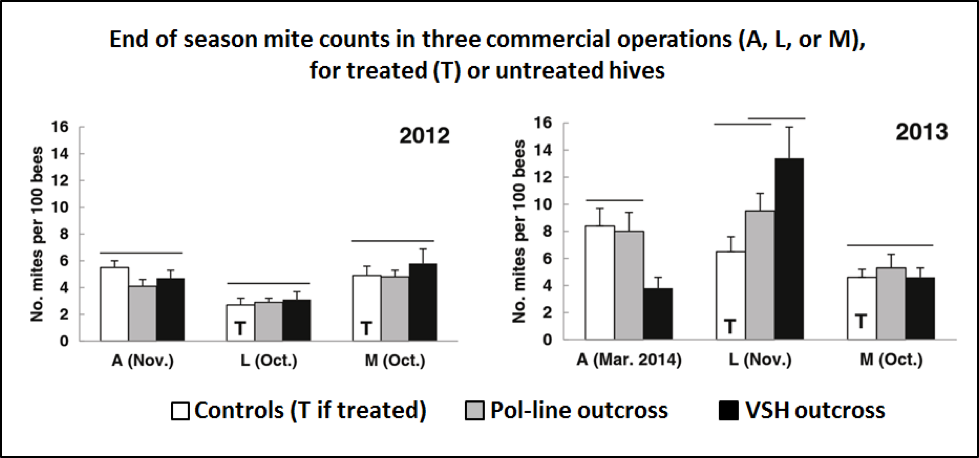The Varroa Problem: Part 4 – Mite-Resistant Bees- Pipe Dream or Plausible?
The Varroa Problem: Part 4
Mite-Resistant Bees—Pipedream or Plausible?
Randy Oliver
ScientificBeekeeping.com
First published in ABJ January 2017
I imagine that some readers may be thinking, “Randy lives in cannabis country with the rest of the fruits and nuts in California—what’s he been putting into his smoker?” And I’m glad to hear that, since smart minds exhibit a healthy degree of skepticism for any claim put forward without strong supportive evidence. Since I feel that this issue is important to the beekeeping industry, I’m happy to offer that evidence, and then let you decide whether I’m merely blowing smoke.
The Necessary Evolution of Mite Management
Fifteen years ago, I planted nearly a hundred fruit trees and grape vines at my place. Once they were established and fruiting, to my dismay I found that in order to bring fruit to the table, that (at least in my region) some of the cultivars needed time-consuming treatments. But others, season after season, have required no special care. Since my time is limited, I’ve been replacing those that required regular spraying with those that take care of themselves. Rather than fighting nature, it’s easier to simply use stock selectively bred for disease resistance in my locale.
Farmers and ranchers worldwide have long realized that it’s generally easier and more profitable to grow or keep stock adapted for your region. Such strains require the minimal amount of inputs and management (which is why, for example, there are few almond growers outside of California’s Central Valley [[1]]). World wide, many beekeepers realize this, and recent research has confirmed it [[2]]. But since there just aren’t enough queens produced for sale in many ecoregions [[3]], the bulk of our managed bees consists of stocks specifically tailored for high-input commercial migratory operations. There’s nothing wrong with that, but there’s no reason to expect such stock to survive without regular treatments against varroa.
Anyway, after playing the Sisyphus role for 25 years, I’m getting sick and tired of fighting the damn mite. If I can grow trees and vines that can deal with pests and parasites by themselves, why the heck wouldn’t I want to keep bees that can do the same?
It’s been a long time coming
This article is not coming off the top of my head–I wrote the first draft back in 2008 [[4]]. But at that time I felt that our industry was not yet ready for it–some hobbyists, perhaps, but not the commercial guys who have the greatest impact upon the managed bee breeding population. As I’ve previously explained, the inevitable failure of amitraz may change that, since without an inexpensive, effective miticide at their disposal, mite control will become more difficult.
So now, after waiting eight years, I feel that the time has come to present the argument that we should finally get serious about dealing with varroa. For thirty years we’ve been managing The Varroa Problem with flyswatters and Band-Aids. We could make beekeeping so much easier if we, as an industry, worked together to shift the genetics of the North American bee population toward stocks that were able to manage varroa on their own.
Proof of concept
I wouldn’t expect any serious beekeeper to waste their time considering my proposal unless I could present firm evidence of plausibility. And as such I offer the following exhibits:
Exhibit A: Apis cerana. This sister species to our bee is the natural host of varroa, and has established a stable and non-threatening host-parasite relationship with the mite..
Apis cerana is nearly identical to our bee, yet has evolutionarily figured out how to keep varroa under firm control. Photograph by Azman, CC BY-SA-3.0.
Exhibit B: The Africanized bees. Although mite resistance varies in this widespread population, in many areas beekeepers find little reason to bother to apply treatments.
Exhibit C: The USDA VSH and Russian stocks. These stocks are maintained without any mite treatments whatsoever, and there is hard data showing that they can perform well in commercial operations [[5]].
Exhibit D: The U.S. feral populations. As I’ve pointed out previously [[6]], there are numerous unbroken maternal lines of feral bees existing in the U.S. that have not been propagated by breeders. They are living proof that many different bloodlines of bees living wild in this country have survived through nearly three decades of varroa pressure.
Exhibit E: The pioneers. John Kefuss, Kirk Webster, and many small-scale breeders are successfully keeping bees of selected stocks without using any mite treatments (there are even a few almond pollinators in this group). It will require expanding numbers of this last subset to convince our industry of the feasibility of using resistant stock. A note: the vocal self-righteous attitude of some of these early adopters doesn’t help their cause—commercial beekeepers copy financial success, not rhetoric.
I visited pioneer Kirk Webster in the early years of his breeding program. It wasn’t easy for him [[7]], but he now runs an entirely treatment-free and profitable operation, producing honey and selling nucs. Photo credit Mike Palmer.
Exhibit F: The Savannah and Cape bee races in South Africa. I saved the best for last. South Africa has a robust bee industry, which was invaded by varroa in 1997. However, unlike as in Europe and North America, few beekeepers chose to use varroacides. Plenty of hives collapsed in the first few years, but both races of indigenous honey bees (of the same species as the bee that we keep) soon showed signs of resistance. In a few years, varroa was considered to be only an incidental pest [[8]].
Practical application: At every bee conference in the U.S., varroa is a major topic. On the other hand, read the Chairman’s Report from the 2016 South African Bee Industry General Meeting—the words “varroa” or “mites” are not even mentioned! [[9]]. And in the most recent issue of the South African Bee Journal, varroa got only brief mention in a single scientific article on bee pests, saying that a new study had figured out the bees’ specific resistance mechanisms [[10]]. How refreshing it would be to not even have to think about varroa.
To be clear, I am not about to advocate going treatment free “cold turkey”—most of us would go out of business in short order (not to mention the collapse of the almond industry). But there is absolutely nothing to keep us from making a smooth transition (I will later describe how we can go about doing this). That is, if we have the will. Personally, the mere thought of beekeeping without regard to varroa brings a smile to my face.
Two exciting new studies
And as obvious as it was that mite resistance was achievable, I still hesitated to write about it, because other researchers were having trouble in understanding the exact mechanisms involved. I’ve spent the past couple of years researching and writing my series Understanding Colony Buildup and Decline (and am now a much better beekeeper because of it). In doing so, I came to realize that if I want to beat the mite, that I need to understand varroa at the same deep level—to put myself into its body and experience the world through its senses, and to achieve the same deep understanding of how some bees have evolved to coexist with this parasite. I now feel that I’m nearing that understanding.
The varroa mite is tiny and blind, and experiences the world in ways nearly incomprehensible to humans. To beat the mite, we need to learn to understand how varroa exists at the scale in the photo above. Photo credit ARS, public domain.
I’ve also spent several hundred hours in developing a mite population model (which I plan to soon make publicly available). The model confirms that mite resistance is achievable by the bees slightly tweaking a few behaviors and chemical cues.
And then in the last few months, two new studies riveted my attention, finally explaining key varroa resistance mechanisms in different types of bees [[11]]. I’ll return to these incredibly important papers later in this series, but to me, they confirmed that there was more than one way for bees to skin the varroa cat.
Practical application: These findings brought to mind the “Zero, one, infinity principle.” That is, in solutions to a problem, there are either none (it’s unsolvable), there’s only one solution, or there are an arbitrary number of ways to solve the problem. The two studies clearly showed that there are indeed any number of ways for bees and varroa to coevolve a working relationship. This fact suggests that regional breeds of mite-resistant bees, as well as commercial bloodlines, may well exhibit different mechanisms for resistance.
Our main challenges
Professional beekeepers have every right to be skeptical of being sold some sort of pipe dream, and can come up with any number of reasons why they think that it will be difficult to shift to mite-resistant stocks. Yeah, change generally comes with problems, but I don’t see any that are insurmountable. I’ve thought this through—the obstacles appear to me to be less of a problem than The Varroa Problem itself.
The first problem is lack of demand (and thus little financial incentive to produce resistant stock). I’m a big believer in the power of the free market. It can drive major changes seemingly overnight. What’s held back adoption of varroa resistant bees is lack of demand. It’s sort of a Catch-22 situation–so long as the customers of the larger queen producers don’t demand mite-resistant stock, the breeders have little incentive to go in that direction. But until truly bulletproof stock is readily available, no one will be picky enough to demand it.
The second problem is that there is a general feeling that it would be too darn hard for Joe Queenproducer to set up a rigorous breeding program, requiring a scientific background and tedious assessment and recordkeeping. Luckily, nothing could be further from the truth—any of the queen producers that I know could easily do it.
Practical application: any large queen producer with at least one semi-isolated mating yard can undertake a serious selective breeding program for mite resistance [[12]]. The more hives involved (hundreds), the better chance at success. You don’t need to be a scientist, nor need special equipment, nor take risk, nor spend a lot of money. I’ll detail exactly how to go about it later in this series.
The main obstacle is not the biological ability of bee stocks to manage mites on their own, but rather the problem with maintaining the reproductive isolation necessary for a breeding program. Luckily, this isolation can be realized by having a mating yard in an area remote from other hives (or ferals), or by simply dominating the drone population with one’s selected stock. And this only needs to occur once each spring during the mating of the selected virgins to the drones produced by selected drone mother hives.
The map above shows the locations of our apiaries (red plus signs; blues are ponds). Obviously, we can control most of the drone population in our mating yards, since our hives return from almonds chock full of drones—ahead of the local hives not taken to almonds.
Practical application: You will need to devote some yards to the breeding program. The good news is that no colonies need to die in the process, you can still use mite treatments, and run nearly all colonies for production or pollination. Really—I’m gonna tell you how to do it.
Here’s the thing: there are only a relatively tiny number of colonies worldwide in serious breeding programs. Just a few big large U.S. queen producers could make much faster progress. The costs involved are truly minimal, and the potential gain, tremendous.
Don’t expect an immediate miracle
If you start from scratch, it’ll take at least several years to develop a truly mite-resistant breed, depending upon the stock that you start with, and how many queens you can involve in the program each season.
Practical application: the good thing is that you can start to realize a benefit long before your stock is bulletproof. If you can reduce your need for treatments to only once a season, that alone may pay for the costs involved in the program.
And don’t delude yourself. You’re not going to be selling “mite-resistant” queens after the first couple of years. Once your stock exhibits consistent resistance, you’ll need to maintain strong selective pressure until the involved traits are “fixed” in the population.
And most importantly, don’t start advertising your stock as “mite resistant” until it truly is.
The need for hard numbers
The worst thing is to advertise queens as being “mite resistant” unless they truly are. And even then, even resistant colonies can be overwhelmed by mites drifting in from poorly-managed nearby hives. This gives “mite resistant” a bad name.
Practical application: Over the years, I’ve tested “mite-resistant” breeder or production queens from many sources. I introduce them into nucs in my home yard, starting identical nucs with my own stock to run side by side. A very few “resistant” queens actually lived up to that name, but the majority succumbed to mites even more quickly than my own stock (and I make zero claim for my own stock being resistant). Beekeepers have every reason to be skeptical of claims for “mite resistance.”
Professional beekeepers have huge overhead costs, and families of employees who depend upon them to successfully keep their hives alive and healthy. They cannot, and will not, take the risk of switching to mite-resistant stock until they see hard numbers that show that such stock is actually going to do the trick—for a mite-resistant stock to crack the market, it will need to produce strong hives for almonds and then make honey, and not be overrun by mites come September.
The above is the kind of hard data that will be required to tempt professional beekeepers to try mite-resistant stock. Horizontal lines above the bars mean no significant difference. Figure modified from ARS testing [[13]].
Practical application: Buyer beware! Monitor any test colonies to track whether they indeed hold mites at low levels. Be prepared to step in with a treatment if necessary. But remember, even if a stock reduces the rate of mite increase by only 10%, you could drop at least one treatment per season. This is going to be a process—don’t expect completely bulletproof mites at the outset.
Difficult doesn’t mean impossible
I’ve personally kept colonies that laughed at varroa, and whose daughters clearly inherited some degree of mite resistance. I feel that I have no one but myself to blame for not being diligent enough in propagating those bloodlines (I failed at managing the drone population).
Personal side note: I’ve done half-assed selection for mite resistance for some years (with clear benefit), but now that I’ve taken the time to understand what’s involved in a realistic breeding program, I’m stepping up my game. Things look promising so far, and I’m excited about one queen line that exhibits a degree of heritability of resistance. I’ll be reporting on my progress.
That said, I’m not about to claim that I have mite-resistant stock. Every spring, after grafting from 30 promising breeders exhibiting very low mite levels, we maintain them without treatments until mid summer. And every year, nearly all of them then require treatment to survive.
I could get discouraged. But instead I remember a quote from Thomas Edison:
Many of life’s failures are people who did not realize how close they were to success when they gave up.
Practical application: I have no illusion that things will change overnight. What I do know is that once enough “early adopters” find that using mite-resistant stock makes beekeeping easier and more profitable, that our industry will eventually reach a tip point, after which queen producers will have a hard time selling mite-susceptible stock. We will soon afterward talk about the days when varroa used to be a problem.
Going beyond flyswatters and Bandaids
We’ve fought varroa with flyswatters and Band-Aids for over two decades. It’s time to move to a more serious and sustainable solution—handing the job over to the bees themselves. There is abundant evidence that this long-term solution is within our grasp. We know our objective; the only question then is what realistic and practical steps we can take to achieve that goal. Over the rest of this series, I will lay out how to do it.
Next: So much to cover—I’m not yet sure, but I’ll eventually answer all your questions.
Aknowledgements
Thanks to Pete Borst for his assistance in research, and to those reality-based pioneering beekeepers at work selecting for mite-resistant stocks (meaning that the bees never allow varroa to reach damaging levels).
Notes and Citations
(Most of the papers cited below are (with a bit of diligence) available open access on the Web).
[1] You could produce almonds anywhere, but the expenses necessary would not be worth the returns.
[2] Büchler, R, et al (2014) The influence of genetic origin and its interaction with environmental effects on the survival of Apis mellifera L. colonies in Europe. Journal of Apicultural Research 53(2): 205-214.
[3] This is a huge business opportunity.
[4] In hindsight, perhaps I shoulda finished researching and writing it at that time– my mind was much sharper eight years ago : (
[5] Danka, RG, et al (2012) Functionality of varroa-resistant honey bees (Hymenoptera:Apidae) when used in migratory beekeeping for crop pollination. Journal of Economic Entomology 105(2):313-321.
Ward, K, et al (2008) Comparative performance of two mite-resistant stocks of honey bees (Hymenoptera: Apidae) in Alabama beekeeping operations. J Economic Entomology 101(3): 654 – 659.
De Guzman, LI (2007) Growth of Varroa destructor (Acari: Varroidae) populations in Russian honey bee (Hymenoptera: Apidae) colonies. Ann. Entomol. Soc. Am. 100(2): 187-195.
[6] https://scientificbeekeeping.com/whats-happening-to-the-bees-part-5-is-there-a-difference-between-domesticated-and-feral-bees/
[7] Kirk used the Bond method, which involves the loss of colonies. It is entirely unnecessary to do this in order to successfully breed for mite resistance.
[8] Allsopp, M (2006) Analysis of Varroa destructor infestation of Southern African honeybee populations. M.S. Thesis, Univ. of Pretoria. http://upetd.up.ac.za/thesis/available/etd-08082007-153050/unrestricted/dissertation.pdf A must read for anyone interested in breeding bees for varroa resistance.
[9] Report of the Chairman South African Bee Industry Association Annual General Meeting 2nd July 2016 http://www.sabio.org.za/wp-content/uploads/2013/10/Chairmans-Report-AGM-2016.pdf
There was considerable concern about the recent invasion of AFB, but no mention of varroa. For more information, see:
Strauss, U, et al. (2015) Impact of Varroa destructor on honeybee (Apis mellifera scutellata) colony development in South Africa Exp Appl Acarol 65: 89. Open access.
Pirk, CWW, et al (2014) A survey of managed honey bee colony losses in the Republic of South Africa – 2009 to 2011. J Apic Res 53:35-42. Open access.
Strauss, U, et al CWW (2013) Seasonal prevalence of pathogens and parasites in the savannah honeybee (Apis mellifera scutellata). J Invertebr Pathol 114:45-52. Open access.
[10] http://sabio.org.za/wp-content/uploads/2016/10/SA%20Bee%20Journal%20August%202016.pdf
[11] Strauss, U, et al (2015) Resistance rather than tolerance explains survival of savannah honeybees (Apis mellifera scutellata) to infestation by the parasitic mite Varroa destructor. Parasitology 143: 374–387.
Page, P, et al (2016) Social apoptosis in honey bee superorganisms. Nature Scientific Reports 6:27210 DOI: 10.1038/srep27210.
[12] No liquid nitrogen testing, instrumental insemination, or recordkeeping involved.
[13] Danka, RG, et al (2015) Selection of VSH-derived “Pol-line” honey bees and evaluation of their Varroa-resistance characteristics. Apidologie 47(3): 483–490.








